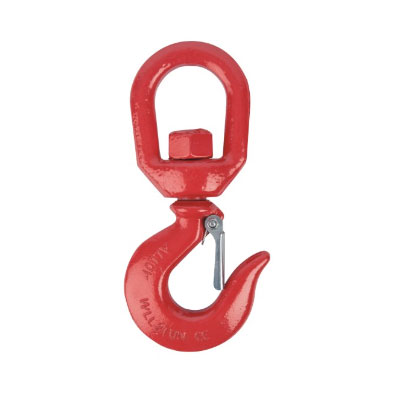Here are some key features and uses of swivel hooks with latch
2024-03-14
Swivel hooks with latch are important components in rigging and lifting operations, providing a flexible and secure attachment point for chains, cables, or slings. These hooks feature a swiveling design that allows for rotation, reducing the risk of twisting or tangling during lifting. The latch mechanism adds an extra layer of security to prevent accidental disengagement of the load. Here are some key features and uses of swivel hooks with latch:
1. Design: Swivel hooks with latch are designed with a hook on one end and a swivel connection on the other end. The swivel connection allows the hook to rotate freely, preventing twisting or tangling of the attached load. The hook is equipped with a latch or safety latch mechanism to securely close over the opening of the hook.
2. Material: These hooks are typically made from high-strength materials such as alloy steel or stainless steel to ensure durability and reliability in lifting applications. The choice of material depends on factors such as load capacity, environmental conditions, and corrosion resistance requirements.
3. Load Capacity: Swivel hooks with latch are available in various load capacities to accommodate different lifting requirements. They are typically rated for specific working load limits (WLL) or breaking strengths to ensure safe and reliable performance under load.
4. Swivel Mechanism: The swivel mechanism on these hooks allows for 360-degree rotation, providing flexibility and preventing twisting or tangling of the attached load. The swivel mechanism is typically equipped with bearings or bushings to ensure smooth rotation under load.
5. Latch Mechanism: The latch mechanism on swivel hooks serves as a safety feature to prevent accidental disengagement of the load. The latch can be spring-loaded or manually operated and is designed to close securely over the opening of the hook when the load is attached.
6. Versatility: Swivel hooks with latch are versatile lifting accessories that can be used in a wide range of applications, including construction, manufacturing, transportation, and material handling. They provide a secure attachment point for chains, cables, slings, or other rigging components.
7. Safety: Proper selection and use of swivel hooks with latch are essential to ensure safety in lifting operations. Operators should follow manufacturer recommendations and industry standards for load ratings, inspection, and maintenance to prevent accidents and injuries.
8. Compliance: Swivel hooks with latch used in lifting applications should comply with relevant industry standards and regulations, such as those set forth by organizations like the Occupational Safety and Health Administration (OSHA) or the American Society of Mechanical Engineers (ASME).
9. Maintenance: Regular inspection and maintenance are crucial to ensure the integrity and performance of swivel hooks with latch. Inspections should include checking for signs of wear, deformation, or damage, as well as verifying proper operation of the latch and swivel mechanisms.
Swivel hooks with latch are essential lifting accessories that provide flexibility, security, and ease of use in rigging and lifting operations. By understanding their features, uses, and safety considerations, operators can ensure the safe and efficient handling of loads in various industrial and commercial settings.



